The article below by Christine Allison was first published in the CAIS website. Kindly note that the pictures/illustrations and accompanying captions written by Kavehfarrokh.com inserted in the article below do not appear in the original CAIS posting.
Introduction
Yazidis, a heterodox Kurdish religious minority living predominantly in northern Iraq, Syria and south-east Turkey, with well-established communities in the Caucasus and a growing European diaspora. Anecdotal evidence of the existence of Yazidi groups in North-Western Persia has not yet been proven. There are probably some 200,000-300,000 Yazidis worldwide. The Yazidis have long been the object of fascination among Orientalists, largely due to their erroneous description by outsiders as ‘devil-worshippers’ (see below). The literature devoted to their religion is disproportionately large, considering how few they are in number by comparison with the large majority of Kurdish Muslims. Their name for themselves is usually, Êzdi, Êzidi, or, in some areas, Dâsini (the last, strictly speaking a tribal name). Some scholars have derived the name Yazidi from Old Iranian yazata (divine being), though the current consensus among Western academics is a derivation from Yazid b. Mo‘âwiya, revered by the Yazidis as an incarnation of the divine figure Sultan Êzi. (Kreyenbroek, 1995, p. 3).
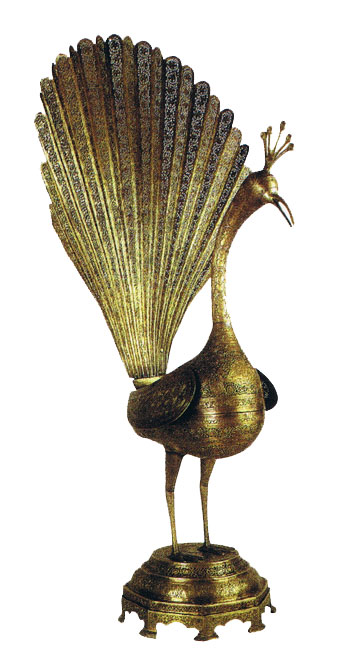
Metalwork representing the spiritual entity Malak Tawous (Saradistribution.com); For more see “The Lalesh Temple and Ceremonies of the Yezidi Kurds“…
Origins
The Yazidis’ cultural practices are observably Kurdish, and almost all speak Kurmanji (Northern Kurdish), with the exception of the villages of Ba’æiqa and Baházânê in Northern Iraq, where Arabic is spoken. Kurmanji is the language of almost all the orally transmitted religious traditions of the Yazidis. Religious origins are somewhat complex. The religion of the Yazidis is a highly syncretistic one: Sufi influence and imagery can be seen in their religious vocabulary, especially in the terminology of their esoteric literature, but much of the mythology is non-Islamic, and their cosmogonies apparently have many points in common with those of ancient Iranian religions. Early writers attempted to describe Yazidi origins, broadly speaking, in terms of ‘Islam’, or ‘Iranian,’ or sometimes even ‘pagan’ religions; however, publications since the 1990s have shown such an approach to be over-simplistic. The origin of the Yazidi religion is now usually seen by scholars as a complex process of syncretism, whereby the belief-system and practices of a local faith had a profound influence on the religiosity of adherents of the ‘Adawiyya sufi order living in the Kurdish mountains, and caused it to deviate from Islamic norms relatively soon after the death of its founder, Shaikh ‘Adi b. Mosâfer.
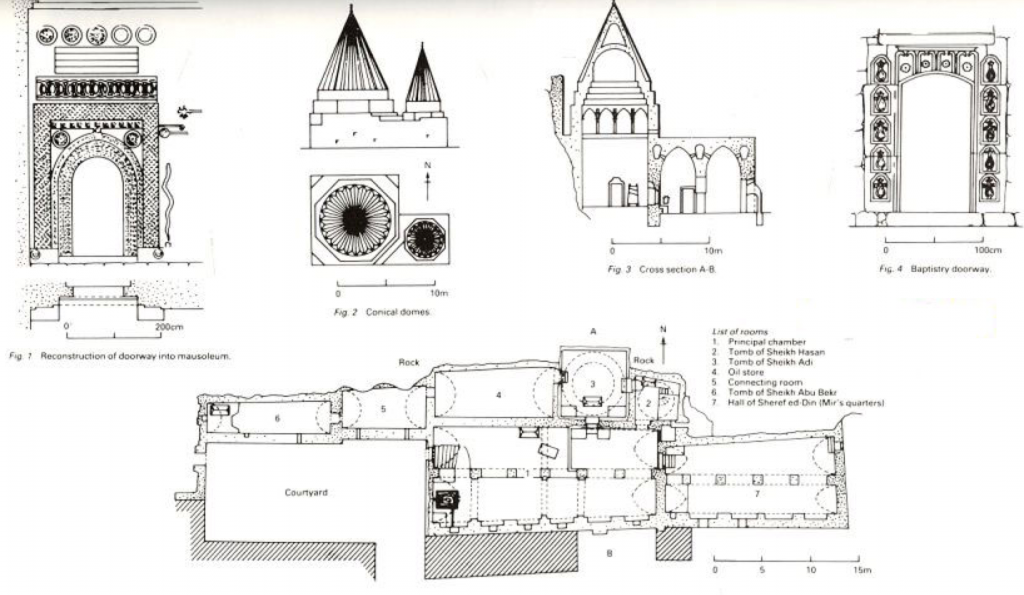
Detailed architectural plan of the Mausoleum at the Temple at Lalesh (Saradistribution.com); For more see “The Lalesh Temple and Ceremonies of the Yezidi Kurds“…
History and Development
‘Adi b. Mosâfer, who was of Omayyad descent, was born c. 1075 CE in the Beka‚a valley. After studying in Baghdad under Abu’l-Khayr Hammâd al-Dabbâs and alongside ‘Abd-al-Qâdir al-Jilâni, he settled in the valley of Lâleæ (some thirty-six miles north-east of Mosul) in the early 12th century. Groups who venerated Yazid b. Mo’âwiya and the Omayyads–already known as Yazidis–had existed for some time in the area; beliefs and practices which were apparently part of an ancient Iranian religion were also retained by some of the local tribes. Shaikh ‘Adi himself, a figure of undoubted orthodoxy, enjoyed widespread influence; he died in 1162 and his tomb at Lâleæ is a focal point of Yazidi pilgrimage. His name, pronounced Âdi or even Hâdi, passed into Yazidi oral tradition, though full knowledge of his identity was lost within the community. Yazidism grew during the period of Atabeg and Mongol rule. Only two generations later, led by Hasan b. ‘Adi, the community had grown large and powerful enough to come into open conflict with the Atabeg of Mosul, who killed Hasan in 1246. At about the same point, it seems, the community began to incur the opprobrium of more orthodox Muslims for its excessive veneration of both Shaikh ‘Adi and Yazid b. Mo’âwiya. During the fourteenth century, important Kurdish tribes whose sphere of influence stretched well into what is now Turkey (including, for a period, the rulers of the principality of Jazira) are cited in historical sources as Yazidi. (Guest, p. 45) Muslim leaders clearly perceived Yazidis as a threat; a significant battle took place in 1414, during which Shaikh ‘Adi’s tomb was razed. After the battle of Ùâlderân (1514; q.v.), Yazidi influence at first remained considerable; a Yazidi was appointed ’emir of the Kurds’ by the Ottomans, and, in the 1530s, Yazidi emirs ruled the province of Sorân for a time. The current family of Yazidi mirs (emirs), claiming Omayyad origins, replaced the descendants of Shaikh Hasan in the sixteenth or seventeenth century. However, as time passed, conversions to Islam became increasingly common and Yazidi power declined. By the end of the Ottoman Empire many important tribes and confederations still had sizeable Yazidi sections, and the dynasty of Yazidi mirs remained dominant within a limited geographical area, but Yazidis had suffered enormously from religious persecution. Until 1849, when provision for their protection was made under Ottoman law, they had not had the status of ‘People of the Book’ (Guest, pp. 103-107; Edmonds, pp. 59-60). In the 19th century complex social and political changes, many related to the Tanzimat reforms, produced an environment of increasing religious intolerance culminating in large-scale massacres of the Christian minorities. The Yazidis, also targets of militant Sunnism, suffered at the hands of Kurdish tribal leaders such as Moháammed Beg of Rowanduz (1832) and Bedir Khan Beg (1840s), as well as Ottoman officials, such as ‘Omar Wahbi Pasha (1893; Guest, pp. 96-97, 134-9; Edmonds, p. 60). There was some co-operation between the minorities; Yazidis of Mount Senjâr sheltered Armenians during the massacres of 1915-16. During the nineteenth and early twentieth century many Yazidis fled to Georgia and Armenia. In the second half of the twentieth century, most of Turkey’s Yazidis, who still lived in fear of religious persecution, emigrated to Germany, and in the 1990s many of Iraq’s Yazidi intelligentsia arrived there, where they play an active role in diaspora affairs, maintaining contact with co-religionists in Iraq and the Caucasus (Guest, pp. 193-203, Ackermann, forthcoming).
Geographical Distribution and Identity
The Yazidi heartland is in Northern Iraq. A substantial community known for its conservatism lives on Mount Senjâr some 80km west of Mosul on the border with Syria. A collection of farming villages and small towns lies in the Šaikân area, in the foothills north-east of Mosul; this area is adjacent to the shrine of Lâleæ and contains the home of the mir and the settlements of Ba’æiqa and Baházânê, home of the qawwâls, reciters of sacred texts. In the 20th century both Šaikani and Senjâri communities struggled for religious dominance. In Syria there are also two main groupings, in the Jazira and the Kurd Dâg@ areas (the latter including the Sem’ân and ‘Afrin communities). However, these are much smaller, probably totaling only about 15,000. In Turkey some Yazidis still live in the villages of the Tur ‘Abdin, south-east of Diyarbakir, remnants of a much more widespread community. The Transcaucasian communities, which once numbered some 60,000, have also declined due to economic and political factors, though accurate statistics remain unavailable. During the 1990s the population in Georgia decreased from some 30,000 to under 5,000, though numbers in Armenia have apparently remained more constant. Diaspora communities have increased correspondingly; most importantly, some 40,000 Yazidis now live in Germany, mainly in the Western provinces of Niedersachsen and Nordrhein-Westfalen. Most are from Turkey, with arrivals during the 1990s from Iraq including some influential figures. This profile may change as the situation in Iraq evolves following the fall of the Saddam regime. A much smaller community exists in the Netherlands. Other groups of Yazidis, in Belgium, Denmark, Sweden, France, Switzerland, the United Kingdom, and in the USA, Canada and Australia, are extremely small, and probably total well under 5,000.
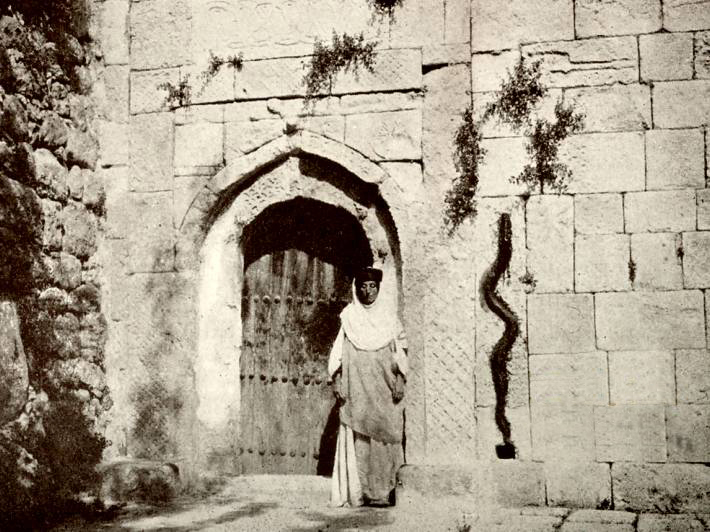
Excellent depiction of a Khatoun at an ingress into the Temple in 1907 (Saradistribution.com). The term Khatoun in this cultural context designates a matriarch; ancient cults such as Mazdakism, Yazdanism, Yazdism as well as the ancient Zoroastrian faith, have often held men and women in equal regard, especially with regard to learning and leadership roles (for more see here).
Many attempts to define the Yazidis’ ethnic identity (notably the policies of the Ba’athist government in Iraq, which designated them as Arabs) have been politically motivated. Apart from a few Arabic-speaking clans, Yazidi communities speak Kurmanji (Northern Kurdish) as their first language, and their cultural practices are Kurdish. Most Yazidis claim Kurdish identity; in Iraq, this view has had the support of the government in the Kurdish Autonomous Region since 1991. In the Caucasus however, particularly in Armenia, to be ‘Kurdish’ is often popularly associated with an Islamic (and thus pro-Azari) identity. Many Caucasian Yazidis, therefore, claim to belong to a separate ethnie, though the politicization of the Kurdish question in Turkey and the influence of the PKK have reportedly caused a number in Armenia to redefine themselves as Kurds. In the diaspora, the Yazidis’ status as Kurds is not debated so much as their religious origin. In nationalist discourse, the Yazidi religion is seen as the ‘original’ Kurdish faith, a view that distinguishes the Kurds from Arabs and Turks. It is sometimes inaccurately presented as a form of Zoroastrianism or, spuriously, as a ‘Cult of Angels.’ In the Caucasus, a hypothesis of Babylonian origins is favored. Such different interpretations of the Yazidis’ origins are closely interlinked with expressions of identity, and tend to be explicable in terms of the prevailing political climate.
Religious Belief and Practice
Contemporary Yazidism is a religion of orthopraxy. Practice, in terms of careful adherence to rules governing all aspects of life, is more important than the role of scriptural text, dogma and professions of personal belief. Two key and interrelated features of Yazidism are: a) a preoccupation with religious purity and b) a belief in metempsychosis. The first of these is expressed in the system of caste, the food laws, the traditional preferences for living in Yazidi communities, and the variety of taboos governing many aspects of life. The second is crucial; Yazidis traditionally believe that the Seven Holy Beings (see below) are periodically reincarnated in human form, called a kâss. Not only does this reinforce the caste system, as the members of the dominant religious castes are the descendants of the most recent manifestations of the Holy Beings in Shaikh ‘Adi and his companions, but it also provides a mechanism for syncretism, as figures from other traditions can be said to be earlier manifestations of the kâss. A belief in the reincarnation of lesser Yazidi souls also exists; like the Ahl-e Haqq (q.v.), the Yazidis use the metaphor of a change of garment to describe the process, which they call kirâs gehorrin, ‘changing the shirt.’ Alongside this, Yazidi mythology also includes descriptions of heaven and hell, and other traditions attempting to reconcile these ideas with the belief-system of reincarnation.
In the Yazidi worldview, God created the world, which is now in the care of a Heptad of seven Holy Beings, often known as ‘Angels’ or haft serr (the Seven Mysteries.) Pre-eminent among these is Tâ’us-ê Malak or Malak Tâ’us, the Peacock Angel, who is equated with Satan by outsiders. Most Yazidis find this identification highly offensive; however, it is clear that Malak Tâ’us is an ambiguous figure. The Ketêbâ Jelwa ‘Book of Illumination” which claims to be the words of Malak Tâ’us, and which presumably represents Yazidi belief (see below), states that he allocates responsibilities, blessings and misfortunes as he sees fit and that it is not for the race of Adam to question him. The Yazidi taboo against the word Š, and on words containing æ and t/t that might (to their ears) recall it, may indicate some perceived connection between this figure and Malak Tâ’us. The reasons for the connection remain unclear. Although some Sufi traditions have presented Satan as a redeemed or holy figure, Shaikh ‘Adi b. Mosâfer was apparently orthodox on the matter. However, pre-Islamic Zoroastrian tradition indicates some link between Ahriman and the peacock, and this ambiguity may predate Islam. Yazidi accounts of creation, which have much in common with those of the Ahl-e Haqq (q.v.) state that the world created by God was at first ‘a pearl’. It remained in this very small and enclosed state for some time (often a magic number such as forty or forty thousand years) before being remade in its current state; during this period the Heptad were called into existence, God made a covenant with them and entrusted the world to them. It has been suggested, on the evidence of pre-Zoroastrian Iranian cosmogony and its similarity to Yazidi cosmogonies, that if the Yazidis’ ancestors venerated a benign demiurge who set the world (in its current state) in motion, the role of this figure may have become ambiguous when they came into contact with Zoroastrians, whose cosmogony was essentially similar, but whose demiurge was Ahriman, who polluted the world. Thus Yazidism would be, not a form of Zoroastrianism, but a religion possessing an Iranian belief-system akin to it.
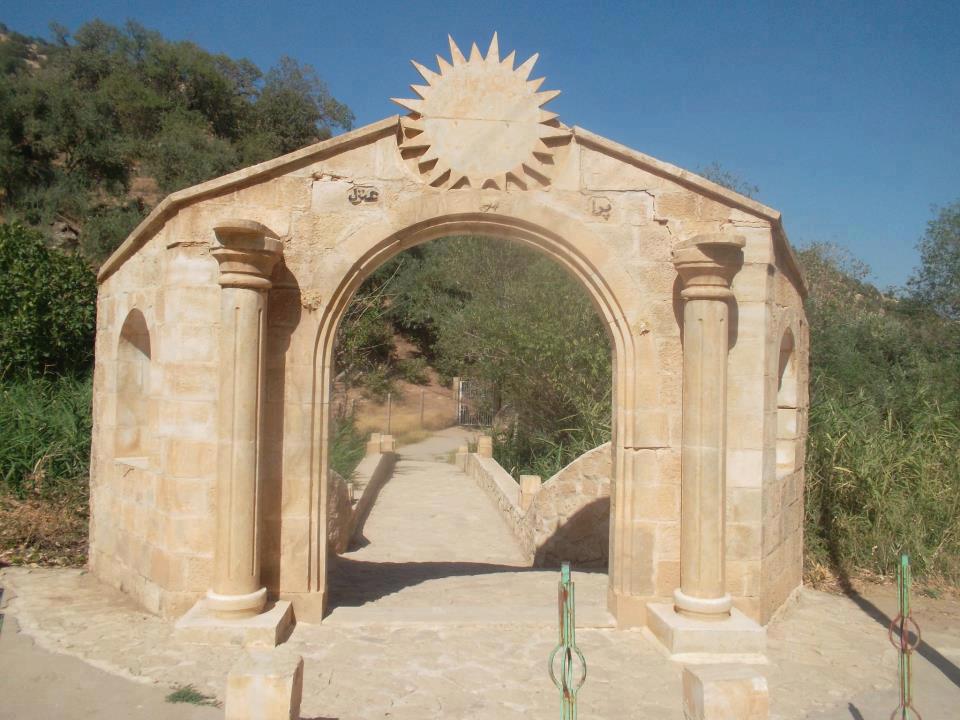
Entrance portal to the Temple of the Yazdis or Yazidis at Lalesh (Saradistribution.com); For more see “The Lalesh Temple and Ceremonies of the Yezidi Kurds“…
Besides Malak Tâ’us, members of the Heptad (the Seven), who were called into existence by God at the beginning of all things, include Shaikh ‘Âdi, his companion Shaikh Hasan, and a group known as the ‘four Mysteries’, Šamsadin, Fakradin, Sajâdin and Nâsáerdin. These latter, according to oral tradition, were the sons of an Êzdinâ Mir, whom Shaikh ‘Âdi met at Lâleæ. All these figures are eponyms of clans of Âdâni shaikhs (see below); in Yazidi accounts of the cosmogony they tend to have other names, and they are also identified in other incarnations, such as Hasan al-Bâsári as an incarnation of Shaikh Hasan. Not all listings of the Seven are identical; sometimes, for instance, Shaikh ‘Âdi himself is identified with Malak Tâ’us, and Shaikh Obakr is added.
The kâss and other holy beings are the focus of frequent veneration. The Heptad, under the names of the families of Shaikh ‘Âdi and his companions, are objects of devotion, but so also are numerous lesser figures, also usually eponyms of clans of shaikhs or pirs (see below), who are requested for help on practical matters. Shaikh Mand, for instance, is believed to cure snakebites, and his descendants may handle snakes safely; the family of Pir Jarwân has power over scorpions. A female figure, Khâtuna Fakra, is associated with help in childbirth. Help from such beings may be sought by consultation with their descendants, or by veneration of a sacred site associated with them–occasionally a tomb, but more often a shrine consisting of a room with a spire, a small votive altar, a sacred tree, or a pool or cave. Many people who know little of the higher-status sacred texts make offerings at such places. Some of these cults appear to be very localized, but others are respected by members of other religions, and Yazidis also solicit help from local saints associated with other religions, especially Christianity (Kreyenbroek, 1995, pp. 91-123, 145-68; Drower, pp. 24-29, 51-60).
Pilgrimage
The holiest Yazidi site is the valley of Lâleæ, site of the tomb of Shaikh ‘Âdi. A sacred microcosm of the world, as it were, it contains not only many shrines dedicated to the kâss, but a number of other landmarks corresponding to other sites or symbols of significance in other faiths, including pirrâ selât (SerâtÂÂ Bridge) and a mountain called Mt. ‘Arafât. The two sacred springs are called Zamzam and Kâniyâ spi ‘The White Spring’. The former rises in a cave below the sanctuary of Shaikh ‘Âdi, the heart of the holy place. Water from the springs is mixed with earth from the holy valley to make barât, little molded balls that are taken away and treated with reverence; they play a part in some rites of passage such as marriage and funerary rites. If possible, Yazidis make at least one pilgrimage to Lâleæ during their lifetime, and those living in the region try to attend at least once a year for the autumn ‘Feast of the Assembly” (see below). As for Lâleæ, pilgrimages to lesser sites may also be undertaken, to seek intercession, in gratitude for prayers answered, or as a vow.
Prayer
Formalized prayer is largely a matter of personal preference and is not obligatory. The practice of praying facing the rising, noonday, and setting sun which is described by travelers seems not to have been universal and is now seen as an ideal rather than a norm. Such prayer should be accompanied by certain gestures, including kissing the rounded neck (gerivân) of the sacred shirt (kerâs). Those who wear the girdle–the black resta for certain dignitaries, the white æutik for other Yazidis–say a prayer when putting it on. Prayers have almost exclusively been transmitted orally; their texts have themes in common but vary in details.
Festivals
Apart from individual rites of passage, such as marriage, baptism, circumcision, and death, Yazidis observe a number of communal festivals, some more widespread than others. The Yazidi New Year falls in Spring (somewhat later than Nowruz). There is some lamentation by women in the cemeteries, to the accompaniment of the music of the qawwâls (see below), but the festival is generally characterized by joyous events: the music of dahol (drum) and zornâ (shawm), communal dancing and meals, the decorating of eggs. Similarly the village tÂewaf (Ar. tÂawâf), a festival held in the spring in honor of the patron of the local shrine, has secular music, dance and meals in addition to the performance of sacred music. Another important festival is the tâwusgerrân (circulation of the peacock) where qawwâls and other religious dignitaries visit Yazidi villages, bringing the senjâq, sacred images representing the peacock and associated with Malak Tâ’us. These are venerated, taxes are collected from the pious, sermons are preached, and holy water distributed. The greatest festival of the year for ordinary Yazidis is the Je‘nâ Jamâ’iya (Feast of the Assembly) at Lâleæ, a seven-day occasion. A focus of widespread pilgrimage, this is an important time for social contact and affirmation of identity. The religious center of the event is the belief in an annual gathering of the Heptad in the holy place at this time; rituals practiced include the sacrifice of a bull at the shrine of Shaikh Šams, the washing of the ‘bier of Shaikh ‘Âdi,’ the practice of samâ’ (see below). Other festivals are more likely to be kept by the few than the many. Religious leaders observe forty-day fasts in summer and winter; a three-day winter fast culminating in the celebration of the birth of the kâssÊzid is kept more widely. The Ùêlkân, a tribe originating in the border areas of Turkey and Syria, keep a winter festival called Bâtizmiya. For some Yazidis at least, the kâss have their feast-days. Counterparts to certain Islamic feasts, including ‘, ‘Id al-fetâr, and Laylat al-barâ’a are also observed by some.
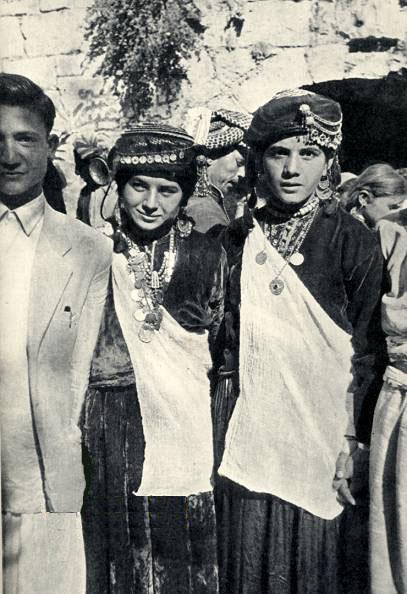
Yazdi or Yazidi youth in the 1950s in Lalesh (Saradistribution.com); For more see “The Lalesh Temple and Ceremonies of the Yezidi Kurds“…
Purity and Taboos
The Yazidis’ concern with religious purity, and their reluctance to mix elements perceived to be incompatible, is shown not only in their caste system, but also in various taboos affecting everyday life. Some of these, such as those on exogamy or on insulting or offending men of religion, are widely respected. Others, such as the prohibition of eating lettuce or wearing the color blue, are often ignored when men of religion are not present. Others still are less widely known and may be localized. The purity of the four elements, Earth, Air, Fire, and Water, is protected by a number of taboos–against spitting on earth, water, or fire, for instance. These may reflect ancient Iranian preoccupations, as apparently do the taboos concerning bodily refuse, hair, and menstrual blood. Too much contact with non-Yazidis is also polluting; in the past Yazidis avoided military service which would have led them to live among Muslims, and were forbidden to share such items as cups or razors with outsiders. The mixing with others brought about by formal education may be a major reason behind the well-known Yazidi taboo on learning to read and write. In the past, only Shaikhs of the Âdâni lineage group had the right to do so. Certain words are the subject of taboos, such as those dealing with cursing or stoning, or those which are felt to sound like the name Š, whose utterance is an unforgivable insult to Malak Tâ’us, obliging any Yazidi who heard it (in the past at any rate) to slay the speaker. Auditory resemblance may lie behind the taboo against eating lettuce, whose name kâs resembles Kurdish pronunciations of kâss. The taboo against eating pork appears to be a custom which follows Islam rather than a specifically Yazidi edict. Prohibitions are also attested, in certain areas at least, against fish, cockerel, gazelle, and various vegetables including okra, cauliflower, and pumpkin.
A widespread myth about the Yazidis’ origin which gives them a distinctive ancestry expresses their feelings of difference from other races. Adam and Eve quarreled about which of them provided the creative element in the begetting of children. Each stored their seed in a jar which was then sealed. When Eve’s was opened it was full of insects and other unpleasant creatures, but inside Adam’s jar was a beautiful boy-child. This lovely child, known as Š (Šahed, son of Jar) grew up to marry a houri and became the ancestor of the Yazidis.
Social and religious groups
The Yazidis divide themselves into three endogamous major castes, with religious orders also playing an important role. Most Yazidis belong to the morid (layman; literally ‘disciple’]) group, which is endogamous, but, within the group, marriage is not restricted. Every morid must have a shaikh and a pir; the lineage of these is determined by the morid’s own heredity. The Shaikhs are divided into three endogamous lineage groups, the Šamsâni, Âdâni and Qâtâni, the latter of which also shares its ancestry with the family of the mir. The pirs are divided into four main groups, and forty clans, most of whom may intermarry. Both groups receive alms from their morids. Tithes paid to the Shaikh are more substantial; however, the difference between the two groups lies not in the nature of their religious tasks, but rather in ancestry (the shaikhs apparently associated with non-Kurdish companions or relations of Shaikh ‘Âdi, and the pirs with his Kurdish companions). At puberty, each morid should also choose a ‘brother’ or ‘sister of the Hereafter’, berâyê or k, normally a Shaikh, who performs certain important rituals at transitional points such as marriage and death.
The Qawwâls or reciters constitute a different class, and come from two clans, the Kurmanji-speaking Dimli and the Arabic-speaking Tazhi, settled in the villages of Ba’æiqa and Beházânê, in the Šaik an area. They specialize in the playing of religious music on sacred instruments, the daf (frame-drum) and æebâb (flute), and in the recital of the sacred hymns or qawls. They also carry out the tâwusgerrân; these were severely curtailed in the twentieth century when crossing international frontiers became more difficult; the Transcaucasian communities in particular were effectively cut off from the Yazidi religious centers.
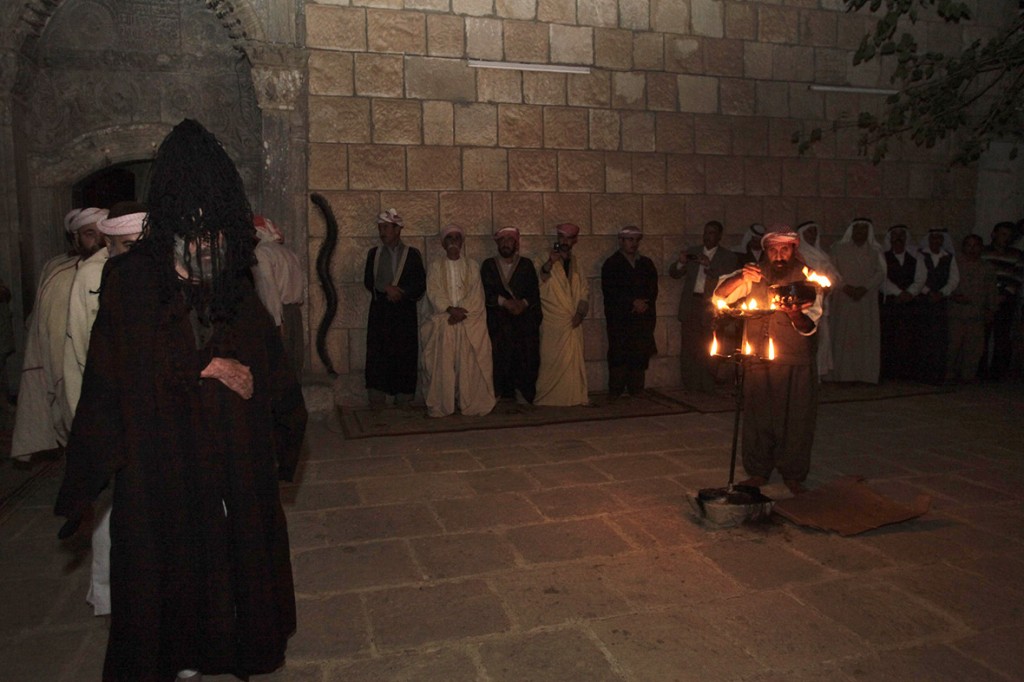
The Yazidi faithful engaging in their “Festival of Eid al-Jamma” (photo taken on 7 October, 2010 & displayed the International Business Times); For more see “The Lalesh Temple and Ceremonies of the Yezidi Kurds“…
There are also religious ‘orders’ whose members may come from different castes. The Faqirs become members of their order by an initiation which was once open to all, but as time has passed have become in effect a hereditary group, with initiation undergone almost exclusively by members of faqir families. They are expected to lead a life of piety and abstinence, by fasting, refraining from drinking and smoking, avoiding any violent behavior. Their clothes, especially their black woolen k or tunic that recalls that of Shaikh ‘Âdi, are considered to be sacred, and their persons must not be harmed. Some are very learned in religious lore. The Kochaks are a small non-hereditary group charged with outdoor labor for Shaikh ‘Âdi, such as cutting wood and drawing water for the shrine. Some in the past have been clairvoyants, miracle workers and interpreters of dreams; a few have acquired political influence in this way, such as the nineteenth-century Kochak Mirzâ of Mount Senjâr, who predicted the fall of Islam.
There are a number of important offices in the Yazidi hierarchy. The Mir (prince) is both temporal and spiritual head of the community; his person is sacred, and in theory all Yazidis owe him spiritual allegiance. In practice the temporal influence of the family, based in Bâ’drê in Šaikân, has declined since the late 18th century, though it remains a substantial landowner, and is active in Kurdish politics. Members of this family are linked to the Qâtâni Shaikhs. The Prince, along with other dignitaries, is a member of the Yazidi Majlesi Roháâni ‘Religious Council’. The Bâbâ Shaikh (Father Shaikh), is the leader of the Shaikhs and must come from the Šamsâni branch. He must lead a pious life; regarded by many as the spiritual leader of the Yazidis, he supervises the Kochaks and many of the ceremonies at Lâleæ cannot take place without his presence. The functions of the Piæ-imâm (Foremost Imam) are less clear; a representative of the Âdâni Shaikhs, he leads certain rituals. The Bâbâ Ùâwuæ, (Father Guardian), guardian of the shrine at Lâleæ, leads a life of piety and celibacy. He lives there permanently and has authority over what happens there; he is assisted by the feqrayyât, (celibate ‘nuns’) who are unmarried or widowed and also care for the sanctuaries. These are very few in number. Successive families of faqirs living there on a temporary basis also look after the fabric of the shrine and take care of guests.
The institution of karâfat, whereby a relationship of sponsorship is created with a man on whose knees a boy is circumcised, exists among Yazidis as for other groups. This often creates close relationships with other communities; since the family of the child may not intermarry with that of the kariv for seven generations, the kariv himself is usually not a Yazidi, and the institution serves to make useful alliances with neighbors. Yazidis in Northern Iraq may also have a mirabbi (literally ‘teacher’), chosen from any caste by rules of heredity.
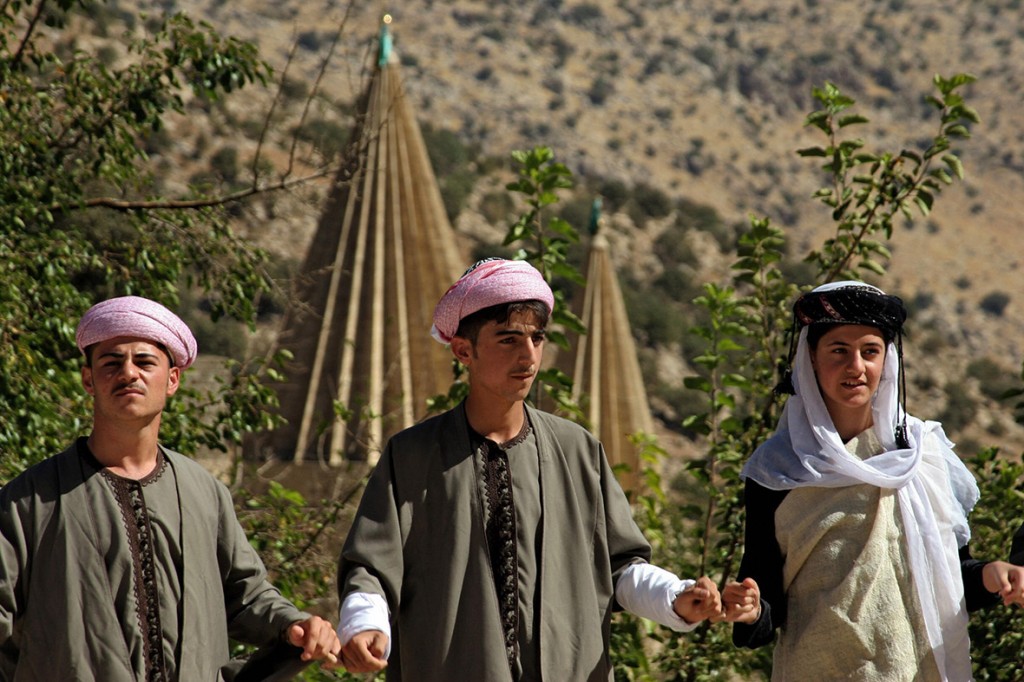
Local Yezidis engage in the traditional Kurdish dance outside the Lalesh temple (photo displayed theInternational Business Times); For more see “The Lalesh Temple and Ceremonies of the Yezidi Kurds“…
Textual traditions
Most Yazidi religious texts have been passed on exclusively by oral tradition, and many features characteristic of oral literature can be seen in them. It is now generally accepted that the manuscripts of the Yazidi Sacred Books, the Masháafâ Reæ and Ketêbâ Jelwa, published in 1911 and 1913, were ‘forgeries’ in the sense that they were written by non-Yazidis in response to Western travelers’ and scholars’ interest in the Yazidi religion, amid a general environment of trading in ancient manuscripts. However, the material within these manuscripts is consistent with the contents of the Yazidi oral traditions, and to that extent they may be considered authentic. Nevertheless, it seems that written texts with the titles Masháefâ Reæ and Ketêbâ Jelwa were known among the Yazidis long before this date, though they have remained unseen even by the vast majority of the community. The latter title is a shortened form of the title of a work by Hasan b. ‘Adi, but it currently seems to denote manuscripts used for divination, which are still kept by certain Âdâni Shaikhs. Other written texts were known; meæur, kept by Pirs, giving accounts of lineages and attached morid families, and kaækul, which included prayers, religious history and some Qawls. These collections may also have included some of the Arabic odes (qasáidas) attributed to Shaikh ‘Âdi which are used in the community. However, there is no evidence that the large corpus of sacred texts once existed in the form of a book.
The core religious texts are the qawls, hymns in Kurmanji which are often dedicated to a kâssand which make frequent allusions to events and persons not explained in the texts. These have, for most of their history, been orally transmitted, though there is some evidence that not all were orally composed. Knowledge and recitation of the qawls has traditionally been the province of the Qawwâl, though their training school no longer exists in their home villages. Few members of the Qawwâl families now learn either sacred texts or sacred instruments and those with the widest knowledge of the Qawls and their interpretation are now from other classes. In 1979 two young Yazidi intellectuals published a number of the qawls, provoking considerable controversy within the community. (A few had been published in the Soviet Union the previous year, but were presented as part of a folklore anthology and largely ignored). By the beginning of the 21st century more had been published in Armenia and a research program in Germany was almost complete. With the assent of the community, this latter aimed to collect and transcribe the many unpublished qawls for use in academic research and the education of Yazidi children, especially in the diaspora. Yazidism is thus being transformed into a scriptural religion.
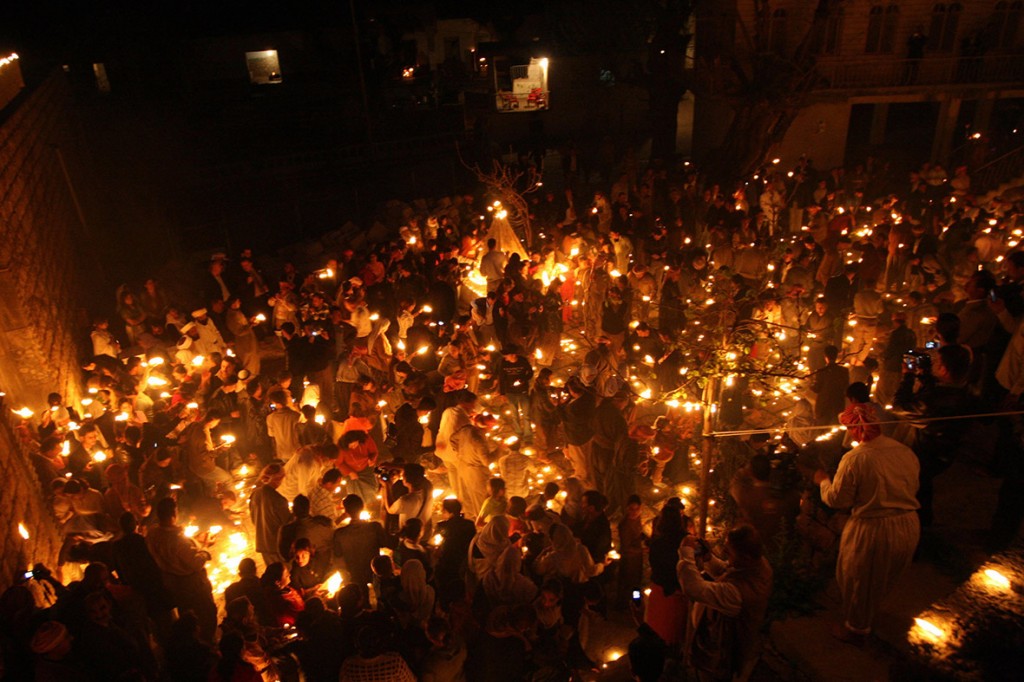
Yazidis lighting candles outside the Lalesh temple in celebration of the Yazidi New Year (photo taken on April 17, 2007 & displayed the International Business Times). The Yazidis celebrate the ingress of light into the world; For more see “The Lalesh Temple and Ceremonies of the Yezidi Kurds“…
The qawls, with their allusions and obscurities, are not easy to understand, and a tradition of interpretation has grown up. Each qawl has a ch or ‘story’ associated with it, which explains its context. Some of these chirôks show signs of having been developed long after the qawl. In general the qawls and the knowledge within them are the province of men of religion, but on certain occasions, a mosáháâbat is given. This is a sermon usually consisting of narrative interspersed with couplets from a qawl, which explains the sacred text, and is aimed at a general audience.
Other types of sacred text exist: the bayt which is difficult to distinguish from the qawl in formal terms, but unlike the secular Kurdish bayt (q.v.) is used to accompany religious events such as tâwusgerrân; the qasáida in Kurdish, often a praise-poem for a holy man which does not formally correspond to the Arabic or Persian qasáida; du’â and dirozâ, prayers for private and public use. There are seven forms of Yazidi samâ’, consisting of music and the singing of hymns, usually a combination of qawl and qasáida; a solemn procession is also often part of these.
Bibliography
A. Ackermann “A Double Minority: Notes on the emerging Yezidi Diaspora” in W. Kokot and Kh. Tölölyan, eds., Religion, Identity and Diaspora. London, forthcoming.
P. Anastase Marie, “La de‚couverte re‚cente des deux livres sacre‚s des Ye‚zîdis,” Anthropos 6, 1911, pp. 1-39.
W. F. Ainsworth, Travels and Researches in Asia Minor, Mesopotamia and Armenia, London, 1841.
M. Bittner, Die Heiligen Bücher der Jeziden oder Teufelsanbeter (Kurdisch und Arabisch), Denkschriften der kaiserlichen Akademie der Wissenschaften in Wien, Phil.-Hist., Klasse, Band 55, Vienna, 1913.
O. and C. Celil, “Qewl û Beytê ÊEzdiya” in Zargotina K’urda/Kurdskij Folklor, Moscow 1978, pp. 5ff.
S. al- Damlûj^, al-Yaz^diyya, Mosul 1949. E.S. Drower, Peacock Angel, London, 1941.
R.Y. Ebied and M. J. L. Young, “An account of the history and rituals of the Yaz^d^s of Mosul,” Le Muse‚on 85, 1972, pp. 481-522.
C.J. Edmonds, A Pilgrimage to Lalish, London, 1967.
R. H. W. Empson, The Cult of the Peacock Angel, London, 1928.
R. Frank, Scheich ‘Adî, der grosse Heilige der Jezîdîs, Berlin, 1911.
N. Fuccaro, The Other Kurds: Yazidis in Colonial Iraq, London,1999.
G. Furlani, Testi Religiosi dei Yezidi, Testi e Documenti per la Storia delle Religioni 3, Bologna, 1930.
J. S. Guest, The Yezidis: A Study in Survival, New York and London 1987, rev. ed. Survival Among the Kurds: A History of the Yezidis 1993.
M. Guidi, “Origine dei Yazidi e Storia Religiosa dell’Islam e del Dualismo,” RSO 12, 1932, pp. 266-300.
P. G. Kreyenbroek, “Mithra and Ahreman, Binyâm^n and Malak Tâwûs: Traces of an Ancient Myth in the cosmogonies of Two Modern Sects,” in Recurrent Patterns in Iranian Religion, ed. Ph. Gignoux, pp. 57-79, Stud.Ir., Cahier 11, Paris, 1992.
Idem, Yezidism–Its Background, Observances and Textual Tradition, Lampeter, Wales, 1995.
Idem, “On the study of some heterodox sects in Kurdistan,” in Islam des Kurdes, Les Annales de l’Autre Islam no. 5, Paris, 1998, pp. 163-84.
Idem, with Kh. Jindy Rashow, God and Sheykh Adi are Perfect: Sacred Hymns and Religious Narratives of the Yezidis, in the series Iranica, ed. M. Macuch, Berlin, forthcoming.
A. H. Layard, Nineveh and its Remains, 2 vols, London, 1849.
R. Lescot, Enquête sur les Yezidis de Syrie et du Djebel Sindjar, Beirut, 1938.
J. Menant, Les Ye‚zidiz : Épisodes de l’Histoire des Adorateurs du Diable, Paris, 1892.
A. Mingana, “Devil-worshippers; their beliefs and their sacred books,” JRAS, 1916, pp. 505-26.
Idem, “Sacred books of the Yezidis,” in ibid., 1921, pp. 117-19.
F. Nau and J. Tfinkdji, “Receuil de textes et de documents sur les Ye‚zidis,” Revue de l’Orient Chre‚tien, 2nd series, vol. 20, 1915-17, pp. 142-200, 225-75.
N. Siouffi, “Notice sur la secte des Ye‚zidis,” JA, ser. 7, vol. 19, 1882 pp. 252-68.
Idem, “Notice sur le Che‚ikh ‘Adi et la Secte des Ye‚zidis,” JA, ser. 8, vol. 5,1885, pp. 78-100.
Kh. Silêman, and Kh. Jindy, Êezadiyatî liber Ronaya Hindek Têkstêd Aînê ÊEzdiyan, Baghdad, 1979, repr. 1995 in Latin script, n.p.



